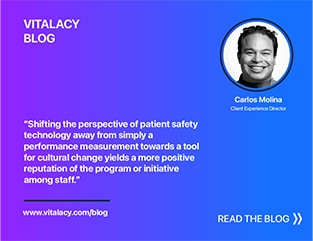
My sordid past with healthcare-associated infections (HAIs) began years ago when my cousin caught an HAI in a hospital emergency room. He had originally gone to the ER for stitches after falling off of his bike, but a few weeks after his visit, he started to feel ill. When he returned to the hospital, the doctor determined that he had caught an infection while getting his stitches. From there, he spent 6 months in the hospital, sick and out of work, because of an infection he caught trying to receive proper care.
My cousin’s experience influenced me to seek a solution that could correct this issue at a foundational level. As an engineer, I became increasingly interested in combining technology with healthcare. I wanted to work on something meaningful, which brought me to Vitalacy. Today, I serve as the company’s VP of Engineering.
There are almost 100,000 deaths yearly that are reportedly caused by HAIs, 70-percent of which are directly caused by poor hand hygiene. When physicians take their Hippocratic oath, they promise first and foremost to do no harm. By being negligent about something as simple as failing to wash their hands, doctors put their patients in danger. For me, it’s more than a health issue — it’s a growing moral dilemma.
The Hospital Hand Hygiene Problem
Hospitals are always busy and frequently hectic environments. Physicians and hospital staff are darting from room to room, interacting with patients, performing procedures, and analyzing their results, among other things. With so much activity going on around the patient, handwashing, unfortunately, can fall by the wayside with each encounter increasing the risk of HAI.
Doctors, nurses, and healthcare staff members are human, and humans are, of course, prone to making mistakes. The case isn’t that doctors, nurses, or staff members are purposefully neglecting to wash their hands. Usually, they simply forget to wash their hands, are too busy, or find that a dispenser is out of soap or sanitizer. With Vitalacy, we use smart technology to address each of these issues.
How Does Vitalacy Work?
Our system combines Internet of Things (IoT), AI, and Cloud Computing to create a solution that effectively monitors people’s handwashing habits within hospitals. We put location beacons in the halls and rooms of hospital units, allowing us to know the location of each person in a hospital wearing a Vitalacy wristband. Observing healthcare providers’ movements throughout the day is the key to our system’s operation.

Every time a doctor, nurse, or a visitor enters or leaves a hospital room, hospital regulations require they wash their hands within 30 seconds of the entry or exit. This wearable device lets us know when someone enters a room, leaves a room, and when a dispenser is activated. When anyone wearing the device enters a room, they’ll get a “buzz” from the wristband that serves as a reminder to wash their hands. A reminder message will also display on the user interface of the watch.

Additionally, the soap and sanitizer dispensers within hospitals communicate to us when someone has activated them to dispense product. Other hand hygiene systems struggle with false positives in their data, wrongly determining anytime someone slightly bumps into or touches a dispenser that soap or sanitizer has been used. We’ve been the first to solve this problem and eliminate false positives using our AI solution to filter out the noise. Using AI, we analyze motions associated with “dispense events,” to differentiate what a dispense activation is and what it is not. This means we’re able to generate more quality data for hospital operators and direct health care providers.
Our predictive dispenser technology uses advanced AI algorithms, so over time we learn how long it takes for a dispenser to empty. For example, we’ll provide a notification when a particular dispenser is going to run out of product, so unit managers can be aware of the shortage and prepare to refill the dispenser.
We know when someone uses a dispenser, when they enter a room, if they washed their hands before or after they entered a room, as well as the duration for which they washed their hands. We also use AI to analyze each user’s path and distinguish between a room entrance and a room exit, reaching an accuracy of 98-percent and above. We gather this data to provide detailed analytics back to the user, encouraging them to improve their hand hygiene habits.

Does Vitalacy See Results?
We may have an advanced wristband solution, but none of it matters if we can’t garner true results. In our previous hospital installations, Vitalacy saw an improvement in hand hygiene compliance by 200-percent, and use of sanitizers increased by 300-percent. Although these aren’t definitive reductions in HAIs, they are, without a doubt, leading indicators.
Our Mission
My desire to lessen the HAI epidemic is deeply motivated by my personal story, but Vitalacy’s main goal is to simplify the workflow and lives of doctors, nurses, and hospital workers, so they’re able to do their jobs to the best of their ability. With Vitalacy, we’re using technology to remind people to more effectively do their jobs. That’s the beauty of answering a healthcare problem with an AI solution — we can use technology to lessen human error and truly improve patient safety.
We hope to lessen the stigma around “big data,” and show doctors, nurses, and hospital staff members the value of welcoming technology as a means of protecting people’s health. We’re disrupting a massive institution, that’s historically used only mechanical objects in its practice, and integrating our smart device to protect patients and, above all, do no harm.
Request a demo of Vitalacy’s Automated Hand Hygiene Monitoring Solution today!
Author
-

Vitalacy is committed to reducing patient harm in healthcare through better hand hygiene and patient safety solutions. Bluetooth-enabled smart sensors and wearables help improve outcomes and Leapfrog Hospital Safety Grades.



